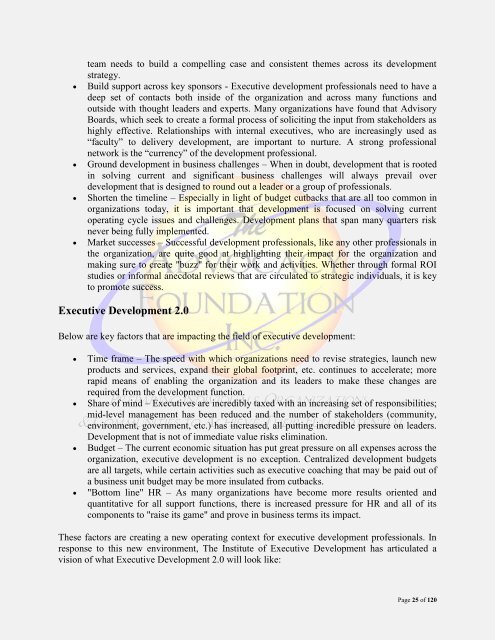Organizational Development - Vol. V, Part II
Organizational Development - Vol. V, Part II
Organizational Development - Vol. V, Part II
You also want an ePaper? Increase the reach of your titles
YUMPU automatically turns print PDFs into web optimized ePapers that Google loves.
team needs to build a compelling case and consistent themes across its development<br />
strategy.<br />
Build support across key sponsors - Executive development professionals need to have a<br />
deep set of contacts both inside of the organization and across many functions and<br />
outside with thought leaders and experts. Many organizations have found that Advisory<br />
Boards, which seek to create a formal process of soliciting the input from stakeholders as<br />
highly effective. Relationships with internal executives, who are increasingly used as<br />
―faculty‖ to delivery development, are important to nurture. A strong professional<br />
network is the ―currency‖ of the development professional.<br />
Ground development in business challenges – When in doubt, development that is rooted<br />
in solving current and significant business challenges will always prevail over<br />
development that is designed to round out a leader or a group of professionals.<br />
Shorten the timeline – Especially in light of budget cutbacks that are all too common in<br />
organizations today, it is important that development is focused on solving current<br />
operating cycle issues and challenges. <strong>Development</strong> plans that span many quarters risk<br />
never being fully implemented.<br />
Market successes – Successful development professionals, like any other professionals in<br />
the organization, are quite good at highlighting their impact for the organization and<br />
making sure to create "buzz" for their work and activities. Whether through formal ROI<br />
studies or informal anecdotal reviews that are circulated to strategic individuals, it is key<br />
to promote success.<br />
Executive <strong>Development</strong> 2.0<br />
Below are key factors that are impacting the field of executive development:<br />
<br />
<br />
<br />
<br />
Time frame – The speed with which organizations need to revise strategies, launch new<br />
products and services, expand their global footprint, etc. continues to accelerate; more<br />
rapid means of enabling the organization and its leaders to make these changes are<br />
required from the development function.<br />
Share of mind – Executives are incredibly taxed with an increasing set of responsibilities;<br />
mid-level management has been reduced and the number of stakeholders (community,<br />
environment, government, etc.) has increased, all putting incredible pressure on leaders.<br />
<strong>Development</strong> that is not of immediate value risks elimination.<br />
Budget – The current economic situation has put great pressure on all expenses across the<br />
organization, executive development is no exception. Centralized development budgets<br />
are all targets, while certain activities such as executive coaching that may be paid out of<br />
a business unit budget may be more insulated from cutbacks.<br />
"Bottom line" HR – As many organizations have become more results oriented and<br />
quantitative for all support functions, there is increased pressure for HR and all of its<br />
components to "raise its game" and prove in business terms its impact.<br />
These factors are creating a new operating context for executive development professionals. In<br />
response to this new environment, The Institute of Executive <strong>Development</strong> has articulated a<br />
vision of what Executive <strong>Development</strong> 2.0 will look like:<br />
Page 25 of 120

















